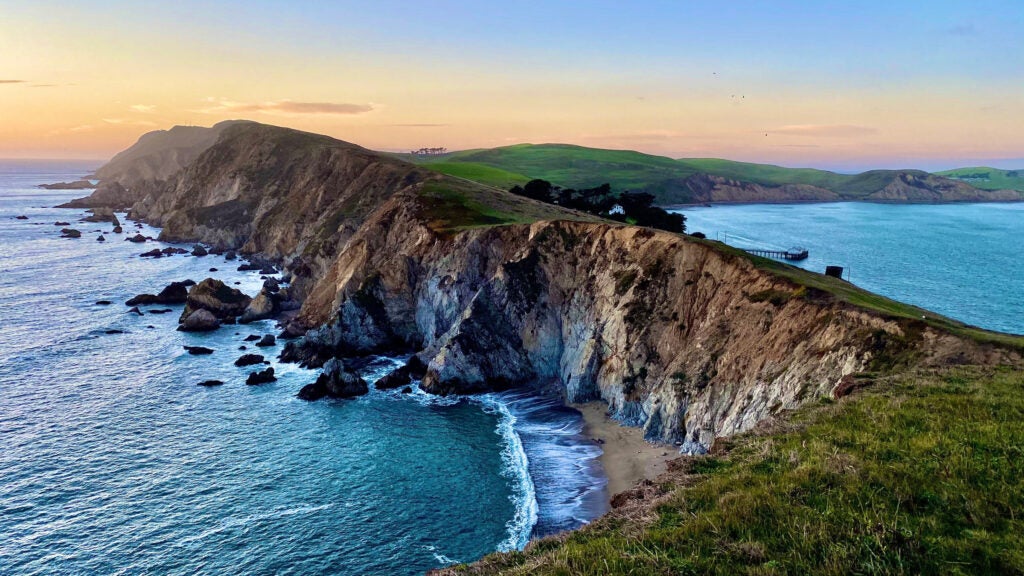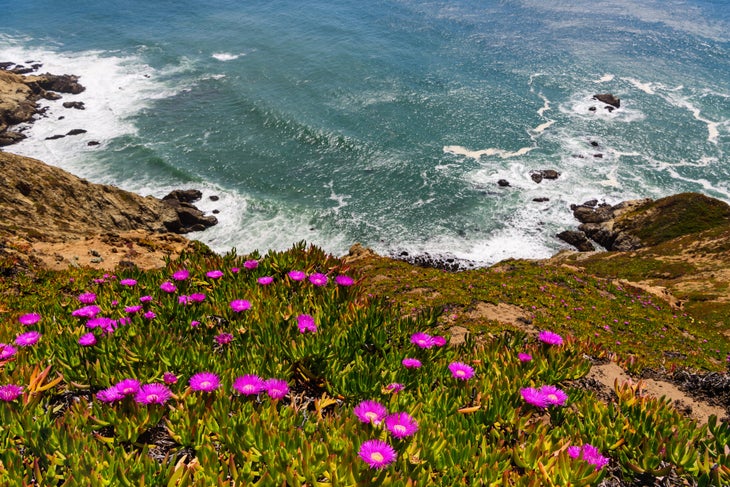



Like many backpackers, hikers, trail runners, and so on, I often go on adventures searching for a certain stillness. It is quiet and nourishing. It is what some might call peace of mind, or happiness, or contentment. What I want during these moments is to be away from all that bothers and irritates and demands my attention and to be returned to myself. To put it in less mystical tones, I want to be off-grid, unplugged, without technology. Nothing shatters stillness quite like the ping of a phone.
I have spent hundreds of hours and perhaps thousands of dollars in search of stillness: meditation retreats in rural foothills across the country, backpacking in the Sierras, camping along the California coast. And I have become increasingly uneasy about the untenability of this search.
It’s true that stillness is free. I couldn’t pay a dollar to get my hands on it. It is a deep, inner pool that waits inside of each of us, reachable only through effort and time, hours spent trudging up mountains and down canyons or struggling with our own insistent thoughts while sitting on a hard cushion in a meditation hall. At the same time, the things I do to reach stillness cost money. Backpacking gear is expensive, taking time off from work is expensive, and going on enough trips to be able to enjoy the stillness of the backcountry is also expensive. To waste hundreds of hours and to spend thousands of dollars can require a lot of privilege.
I wanted to get away from all the noise of wondering about privilege and exceptionalism, the myth of individual meritocracy, and whether stillness really is something that can only be paid for or earned through individual effort, and a heady exertion of will. The way to do this, I thought, was by heading into the peace and quiet of the backcountry, alone.
This spring, after an unusually wet winter without much camping, I planned a solo and phone-free backpacking trip to Point Reyes. I would make the short and pleasant hike along the shore to Coast Camp, its great eucalyptus sentinel untoppled by months of rain that had brought down lesser giants. I would climb the ridgeline through bishop pine and douglas fir to the newly reopened Sky Camp; I would behold through fire-thinned forest the wide Pacific, Farralones bared to the southwest, the hulk of the headlands to the north. Away from not only technology, but the source of technology’s content—people!—I would discover a pinnacle of stillness.

But as soon as I started planning my trip, I realized a couple of important things.
I didn’t want to do it. It was my partner’s spring break. She has a demanding job with an inflexible schedule, and going backpacking alone during one of her few breaks would have required me to cut into time we otherwise would have spent together. Another friend with whom I have shared many happy adventures also happened to have days off from work that week. And lest I veer into dishonesty by way of omission, I am what can be called, in technical terms, a “scaredy cat.” A compulsive catastrophizer. A danger ranger with full and oppressive jurisdiction over all of the lands and all of the seas. I am the exclusive manager of a crisis call-center fielding calls that are, also, exclusively from me—generally about whether the noise I’ve just heard outside my tent is a mountain lion, a serial killer, or both.
Being afraid is, in fact, one of the things I wanted to write about on my solo trip, including the ways in which technology does offer connection to people, to safety, to rescue. I chose Point Reyes as the site for my would-be first foray into solo, technology-free backpacking precisely because it is, generally, full of people, and thus less scary. And yet, if I was going to write about the pursuit of technology-free stillness, didn’t I need to be alone? Shouldn’t I be willing to pay the price of solitude?
My phone, though it does not ensure the safety of my body, does allow me quicker access to the people I love. I do not want to pull away so quickly from this enmeshment, this love, this connection, and—yes—this safety.
Our lives today are absolutely saturated with technology. In 2022, an app-monitoring firm found that people across the world were spending an average of 4.8 hours per day on mobile apps. Studies on digital addiction and screen time published by the National Bureau of Economic Research and the Pew Research Center reveal a lack of choice when it comes to our phones and the places they take us: sites designed, often explicitly, to tether us by the eyeballs to our screens. The impacts can be devastating to our mental health and wellbeing, and may be tied to rising rates of depression and anxiety.
A cultural movement to turn away from technology is growing in response. Articles celebrate the return to flip phones in elite private schools. New York Times bestsellers and $675 workshops (authored by the same person that taught companies how to create addictive products in the first place) encourage us to fight digital addiction. Documentaries like The Social Dilemma invite the engineers responsible for building Instagram and Facebook to discuss exactly how those products are sucking at our time and wellbeing, and how individual people can fight back.

Underlying this movement is a sense of exceptionalism. Individuals can choose to disconnect from technology and remove themselves from digital addiction. We can increase our own wellbeing by paying for a workshop, hiring a nanny instead of plopping our children down in front of an iPad, or—ahem—going on a meditation retreat, or backpacking, or camping. But as journalist Johan Hari points out in his book, Stolen Focus, the problem of digital addiction is a societal one. Solutions that focus on individuals are missing the much larger issue.
Access to technology used to be the ultimate marker of privilege. Tech users could boast both a surfeit of money as well as a suggested surfeit of knowledge, or at least information. But increasingly, the privilege is to be free from technology. All you need to do to get away from your phone is pay enough money, or have enough willpower. Being able to turn away from technology has begun to reflect the same abundance of choice, time, and money that having technology used to.
Once I started to understand these arguments, I started to realize why I really didn’t want to go on, or write about, a solo and technology-free backpacking trip. I am a woman. I am a small and gay and Black woman. I am, in other words, a human made of destructible meat and bone. As mentioned above, I am also a scaredy cat that worries, perhaps inordinately, about every worst-case-scenario. My phone, though it does not ensure the safety of my body, does allow me quicker access to the people I love, who I know worry about me and my body’s safety. I do not want to pull away so quickly from this enmeshment, this love, this connection, and—yes—this safety.

I do not want to reinforce the argument that we can counter systemic problems—digital addiction on the one hand, violence against queer, femme, and Black people on the other—with individual choices. I do not want to reaffirm the belief that in order to find inner peace, calmness, or contentment I must go away, leave my loved ones, be the solitary hero of my journey. Because to survive and to thrive alone nearly always means having to carry more resources than if you were not alone. Carry one whole tent alone, or carry half a tent together.
Constant connection through technology does take a toll on our mental, physical, and social wellbeing. When I return from my tech-free experiences, I always feel refreshed. But I also always return to a world that is still full of stressed out, tech-addled, angry people. Individual retreats into technology-free wildernesses are not a panacea to a systemic problem; they should be reminders that mental health and wellbeing are ultimately communal and collective needs, and community and collective responsibilities. We need solutions that give people permission, while in community, to get off of our phones and computers, to be happy and well without having to be apart from everyone else. Go camping with your friends, and share your resources. Invite your parents on a hike. Talk to your kid’s teachers about limiting phone use, at least during recess or other outdoor time. It’s easier to look away from your phone if there are other human faces to look at instead.
In conclusion, I went to Point Reyes with my loved ones. We did bring our phones, but there was no cell service, and we found the connection we needed in each other, anyway. We walked along the coast; we beheld the eucalyptus; we slept, lulled by the night calls of adolescent humans at the larger group site. We hiked to the top of Mt. Wittenberg (FYI: there is no view); we ate tinned oysters and sardines above the Pacific. At one point, we sat on the sand, still wet from rain, and watched the sun melt into the onrushing waves. Someone (it was me) got their phone out to take a photo, and not one of us was the less connected or quiet or happy or still for it; we were in that fine mesh of contentment, that softly moving container, holding us and holding all.
Stillness does not require solitude, it does not require disconnection, it does not require individual exceptionalism. It is, in fact, the silencing of our anxieties and fears that allows us this most profound and human of revelations: We are not, we are never, we are in fact incapable of being alone. Stillness—that is, happiness—can only be shared. It is in the sharing of ourselves with people, with animals, with land that it arises.
From 2023

